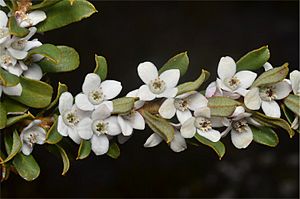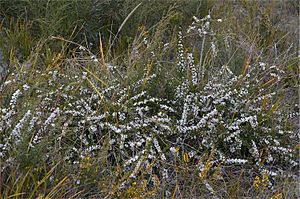Tasmanian wax-flower facts for kids
Quick facts for kids Tasmanian wax-flower |
|
|---|---|
 |
|
| Near Coles Bay, Tasmania | |
| Scientific classification | |
| Genus: |
Philotheca
|
| Species: |
virgata
|
| Synonyms | |
|
|
The Tasmanian wax-flower, officially called Philotheca virgata, is a special kind of flowering plant. It belongs to the Rutaceae family, which also includes citrus fruits. This plant is found only in south-eastern Australia, meaning it is endemic to that area. It grows as a tall, thin shrub with unique leaves and pretty white or pale pink flowers. What makes it extra special is that it's the only plant in its group, Philotheca, that has four sepals and four petals on each flower.
What Does It Look Like?
The Tasmanian wax-flower is a slender, upright shrub. It usually grows to be about 1 to 2 meters (about 3 to 6.5 feet) tall. Its branches have small, bumpy spots that look like warts.
The leaves of this plant are directly attached to the stem, meaning they don't have a stalk. They are shaped like a narrow wedge or an egg, with the narrower part at the bottom. Each leaf is about 10 to 20 millimeters (0.4 to 0.8 inches) long and 2 to 4 millimeters (0.08 to 0.16 inches) wide. The top surface of the leaves also has those small, warty bumps.
The flowers grow one by one at the very end of the branches. Each flower sits on a thin stalk, called a pedicel, which is about 4 to 6 millimeters long. The plant has four sepals, which are like small, round, fleshy leaves that protect the flower bud. They are about 1 millimeter long.
The four petals are white or a light pink color. They are broadly oval-shaped and about 5.5 millimeters long. Inside the flower, there are eight stamens, which are the parts that produce pollen. They are about 8 millimeters long and have tiny hairs on them.
You can see the Tasmanian wax-flower blooming from May to December. After flowering, it produces a fruit that is about 5 millimeters long and has a short, pointed tip, like a small beak.
How Did It Get Its Name?
The Tasmanian wax-flower was first officially described a long time ago, in 1840. A botanist named Joseph Dalton Hooker wrote about it. He used notes from another botanist, Allan Cunningham, who had originally given it the name Erisotemon virgatus. Hooker published this description in a science magazine called The Journal of Botany.
Later, in 1998, another botanist named Paul Wilson decided to change the plant's name. He moved it to a different group of plants, and so its name became Philotheca virgata. He published this new name in a journal called Nuytsia.
Where Does It Grow?
The Tasmanian wax-flower grows in specific types of environments. You can find it in heathland, which is an open area with low-growing shrubs, and in forests. It lives in coastal areas of southern and western Tasmania. You can also find it in New South Wales, south of a town called Eden, and in the very north-east part of Victoria.


